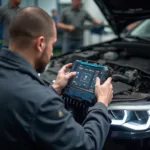Understanding how your OBD2 scanner retrieves emissions data is crucial for passing a smog test. This article dives deep into the process, explaining how the system works and what data is collected to ensure your vehicle meets environmental regulations.
Decoding the OBD2 Emissions Data Retrieval Process
Your car’s On-Board Diagnostics II (OBD2) system is a sophisticated network that constantly monitors various components related to emissions. When you connect an OBD2 scanner, it communicates with the vehicle’s Engine Control Unit (ECU), also known as the Powertrain Control Module (PCM), to access this valuable data. The ECU is the brain of your car’s emissions system, continuously analyzing sensor inputs and adjusting parameters to optimize performance and minimize pollution. This data is what the smog technician uses to determine if your vehicle is operating within acceptable emission limits.
What Emissions Data Does OBD2 Collect?
The OBD2 system gathers information from a range of sensors, providing a comprehensive overview of your vehicle’s emissions performance. These sensors monitor key parameters such as:
- Oxygen Sensors (O2): These sensors measure the oxygen content in the exhaust gases, helping the ECU adjust the air-fuel mixture for optimal combustion and reduced emissions.
- Mass Air Flow (MAF) Sensor: This sensor determines the amount of air entering the engine, which is crucial for calculating the correct fuel injection amount.
- Manifold Absolute Pressure (MAP) Sensor: The MAP sensor measures the pressure inside the intake manifold, providing data about engine load and air density.
- Engine Coolant Temperature (ECT) Sensor: The ECT sensor measures the engine’s operating temperature, which influences the air-fuel mixture and emissions control strategies.
- Catalytic Converter Temperature Sensor: This sensor monitors the temperature of the catalytic converter to ensure its efficient operation in reducing harmful pollutants.
- Evaporative Emission Control System (EVAP): The EVAP system prevents fuel vapors from escaping into the atmosphere, and the OBD2 system monitors its integrity for leaks and malfunctions.
Understanding the role of these sensors is vital for comprehending how the OBD2 system obtains the data required for a smog test. A malfunctioning sensor can lead to inaccurate readings and potentially cause your vehicle to fail the test.
How the Smog Test Uses OBD2 Data
During a smog test, the technician connects an OBD2 scanner to your vehicle’s diagnostic port. The scanner then retrieves diagnostic trouble codes (DTCs), freeze frame data, and readiness monitors. DTCs indicate specific problems within the emissions system. Freeze frame data captures the operating conditions when a DTC was set, providing valuable diagnostic information. Readiness monitors assess the functionality of various emissions control systems. These data points collectively provide a detailed snapshot of your vehicle’s emissions performance.
Why is My Check Engine Light On?
A common concern among car owners is the dreaded check engine light. This light can illuminate for various reasons, including emissions-related problems. The OBD2 system will store a DTC when an issue is detected, triggering the check engine light. It’s crucial to address these issues promptly, as they can negatively impact your vehicle’s emissions and overall performance.
“Regularly checking your car’s OBD2 data with a reliable scanner can help prevent unexpected issues and ensure your vehicle is always running smoothly,” says automotive expert, John Smith, ASE Certified Master Technician.
Ensuring Your Car Passes the Smog Test
Regular maintenance is key to keeping your vehicle’s emissions system in optimal condition. Simple steps like regular oil changes, air filter replacements, and spark plug maintenance can significantly impact your vehicle’s emissions output. Addressing any check engine lights promptly and using a quality fuel can also help ensure your car passes the smog test.
“Don’t wait until your smog test is due to address emissions problems. Regularly monitoring your vehicle’s OBD2 data can help identify potential issues early on,” advises Maria Garcia, Environmental Engineer at GreenTech Solutions.
Conclusion
Understanding how OBD2 retrieves emission data is crucial for passing your smog test. By understanding the system, you can take proactive steps to maintain your vehicle and minimize its environmental impact. Regular checks, prompt repairs, and proper maintenance will ensure your car is running efficiently and meets emission standards.
FAQ
- What is OBD2? On-Board Diagnostics II (OBD2) is a standardized system that allows external devices to access diagnostic information from a vehicle’s computer.
- What is a smog test? A smog test, also known as an emissions test, is a procedure designed to measure the pollutants emitted by a vehicle’s exhaust system.
- How can I prepare my car for a smog test? Regular maintenance, such as oil changes, air filter replacements, and spark plug maintenance, can significantly improve your chances of passing.
- What does a check engine light mean? A check engine light can indicate various issues, including emissions-related problems.
- What is a DTC? A Diagnostic Trouble Code (DTC) is a code stored in the vehicle’s computer that indicates a specific malfunction.
- What are readiness monitors? Readiness monitors are tests performed by the OBD2 system to assess the functionality of various emissions control systems.
- How often should I check my OBD2 data? It’s recommended to check your OBD2 data periodically, especially if you notice any unusual performance issues or the check engine light illuminates.
Need help with your OBD2 scanner or have further questions? Contact us via WhatsApp: +1(641)206-8880, Email: [email protected] or visit us at 789 Elm Street, San Francisco, CA 94102, USA. Our 24/7 customer support team is always ready to assist you.

